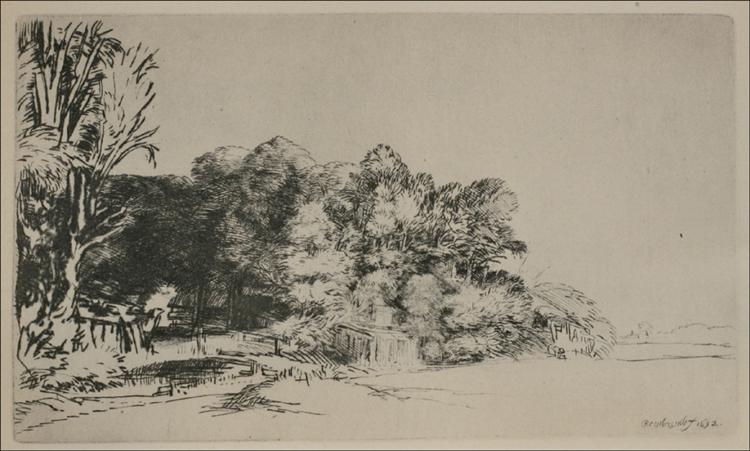Description
Rembrandt's The View (1652) presents a unique interpretation of light, atmosphere and introspection, elements that are characteristic of the Dutch master. At first glance, the composition reveals itself as a landscape where light and shadow play a primary role, a masterful technique that Rembrandt used throughout his career to explore not only physical reality, but also emotional reality. The work, like many of his paintings, reflects his mastery of chiaroscuro, in which a remarkable attention to the representation of natural light is seen.
At the centre of The View is a raised horizon suggesting an expanse of natural landscape, with a horizontal format inviting the viewer to step into the scene. The brushstrokes are loose and expressive, creating textures that seem almost tactile, which is common in Rembrandt's work. The colour palette is predominantly earthy, with shades of greens and yellows evoking a sense of warmth. This use of colour not only sets the tone for the painting, but also reflects the artist's deep respect for nature and for the subtleties of the Dutch landscape.
Unlike other Rembrandt works that feature a multitude of characters, The View is remarkably austere in this respect. It lacks prominent human figures, which could be interpreted as a reflection of a search for tranquility and contemplation, a recurring theme in landscape works of the period. However, it is clear that the work can be read as a symbol of Rembrandt's own state of mind, an invitation to meditation and connection with the natural environment.
An intriguing aspect of The View is its originality in using landscape as an expressive medium, lending an almost poetic character to the composition. During the 17th century, landscape as a pictorial genre was booming in the Netherlands, and Rembrandt was among the artists who evolved in this field. However, by managing to infuse his landscapes with an emotional charge that resonated beyond simple visual representation, he established himself as a pioneer in the internal narrative of landscape.
The influence of nature can also be seen in the way the work explores the transition between light and darkness, a symbol that has been interpreted variously throughout the history of art. Thus, "The View" can be considered not only a representation of a physical environment, but also a reflection on the human condition and the search for a deeper meaning in existence.
Entering into the realm of comparison, it is possible to observe that although Rembrandt is primarily known for his portraits and historical scenes, The View shares similarities with contemporary works by artists such as Jacob van Ruisdael and Aelbert Cuyp, who also explored the Dutch landscape. However, Rembrandt's unique imprint, marked by his treatment of light and emotional intimacy, offers a distinctive perspective that makes this work an exceptional example within his catalogue.
In conclusion, Rembrandt's "The View" is a work that, despite its apparent simplicity, contains a universe of sensations and reflections. Its ability to evoke a sense of peace through light, earthy colors and its deep connection with the landscape, make it a significant piece for the study of Baroque art and the evolution of landscape as a genre. Rembrandt, through this work, invites us to look beyond the visual, reminding us that true beauty lies both in the external landscape and in the internal landscape of our being.
KUADROS ©, a famous painting on your wall.
Hand-made oil painting reproductions, with the quality of professional artists and the distinctive seal of KUADROS ©.
Painting reproduction service with satisfaction guarantee. If you are not completely satisfied with the replica of your painting, we will refund 100% of your money.

